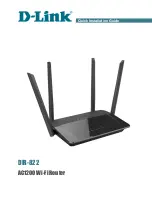
To maximize stability, the hop count RIP uses to measure distance must have a low maximum value. Infinity (that is, the network is unreachable) is defined as 16
hops. In other words, if a network is more than 16 routers from the source, the local router will consider the network unreachable.
RIP can also be slow to converge (to remove inconsistent, unreachable or looped routes from the routing table) because RIP messages propagate relatively
slowly through a network.
Slow convergence can be solved by using split horizon update, where a router does not propagate information about a route back to the interface on which it
was received.This reduces the probability of forming transient routing loops.
Hold down can be used to force a router to ignore new route updates for a period of time (usually 60 seconds) after a new route update has been received.This
allows all routers on the network to receive the message.
A router can ‘poison reverse’ a route by adding an infinite (16) hop count to a route’s advertisement.This is usually used in conjunction with triggered updates,
which force a router to send an immediate broadcast when an update of an unreachable network is received.
RIP Version 1 Message Format
There are two types of RIP messages: routing information messages and information requests. Both types use the same format.
The Command field specifies an operation according the following table:
Command
Meaning
1
Request for partial or full routing information
2
Response containing network-distance pairs from sender’s routing table
3
Turn on trace mode (obsolete)
4
Turn off trace mode (obsolete)
5
Reserved for Sun Microsystem’s internal use
9
Update Request
10
Update Response
11
Update Acknowledgement
RIP Command Codes
The field Version contains the protocol version number (1 in this case), and is used by the receiver to verify which version of RIP the packet was sent.
RIP 1 Message
RIP is not limited to TCP/IP. Its address format can support up to 14 octets (when using IP, the remaining 10 octets must be zeros). Other network protocol
suites can be specified in the Family of Source Network field (IP has a value of 2).This will determine how the address field is interpreted.
RIP specifies that the IP address, 0.0.0.0, denotes a default route.
The distances, measured in router hops are entered in the Distance to Source Network, and Distance to Destination Network fields.
RIP 1 Route Interpretation
RIP was designed to be used with classed address schemes, and does not include an explicit subnet mask. An extension to version 1 does allow routers to
exchange subnetted addresses, but only if the subnet mask used by the network is the same as the subnet mask used by the address.This means the RIP version
1 cannot be used to propagate classless addresses.
Routers running RIP version 1 must send different update messages for each IP interface to which it is connected. Interfaces that use the same subnet mask as
the router’s network can contain subnetted routes, other interfaces cannot.The router will then advertise only a single route to the network.
RIP Version 2 Extensions
RIP version 2 includes an explicit subnet mask entry, so RIP version 2 can be used to propagate variable length subnet addresses or CIDR classless addresses. RIP
version 2 also adds an explicit next hop entry, which speeds convergence and helps prevent the formation of routing loops.
RIP2 Message Format
The message format used with RIP2 is an extension of the RIP1 format:
RIP version 2 also adds a 16-bit route tag that is retained and sent with router updates. It can be used to identify the origin of the route.
Because the version number in RIP2 occupies the same octet as in RIP1, both versions of the protocols can be used on a given router simultaneously without
interference.
RIP Configuration
101
Allied Telesyn AT-9724TS High-Density Layer 3 Stackable Gigabit Ethernet Switch
















































